In February 2011, we found ourselves charging back and forth across Bolivia. We rushed from the Lake Titicaca region, all the way down to Uyuni, so that we could meet some friends for a tour of the salt flats. If you saw that video, you’ll know we bailed out on them after we picked up a nasty intestinal parasite. We eventually returned to Uyuni to do the tour again, but not before going all the way back to La Paz for a week or so.
We self medicated there and, once we were feeling up to it, decided to mountain bike down the World’s Most Dangerous Road – its real name, the North Yungas Road – which connects La Paz, high in the Andes, to the Amazon Basin, thousands of meters below.
We recorded our voice-overs a day or two after the ride, while the memories were fresh. That painted background was actually the wall of our hotel room in La Paz. Both Oksana and I had a lot to say; each of us spoke into the camera for more than 20 minutes. (We really need to be more concise.) This project was a nightmare to edit down.
The final video runs almost 12 minutes and has a lot of information about the road and why it’s considered the most dangerous in the world. If you’re interested, here are a few more tidbits that were left on the cutting room floor:
- Much of the shaky cam footage in this video was from our Contour HD, helmet-mounted camera. We brought it along with us for just this kind of thing, though we got to use it precious few times on our round-the-world trip. I wouldn’t normally include such bouncy footage – to say nothing of the rain-spattered shots – but I actually think it paints a decent picture of what the ride was like.
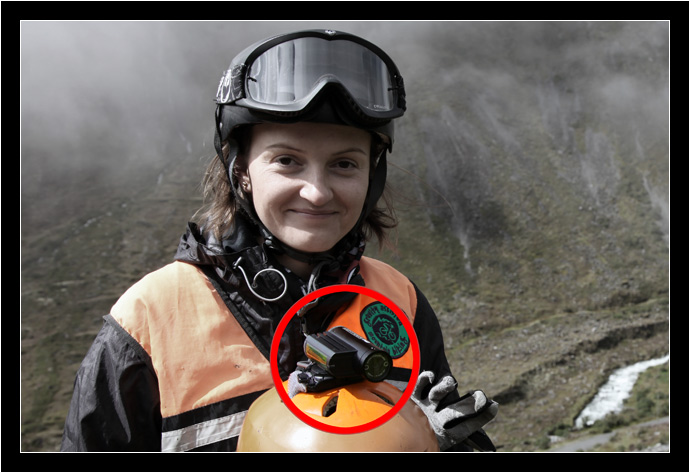
- I doubt anyone will ever know the true number of deaths that have occurred on the North Yungas Road. It was built in the 1930s and some people claim that literally hundreds of people have died every year since. The Bolivian government does not keep complete records.
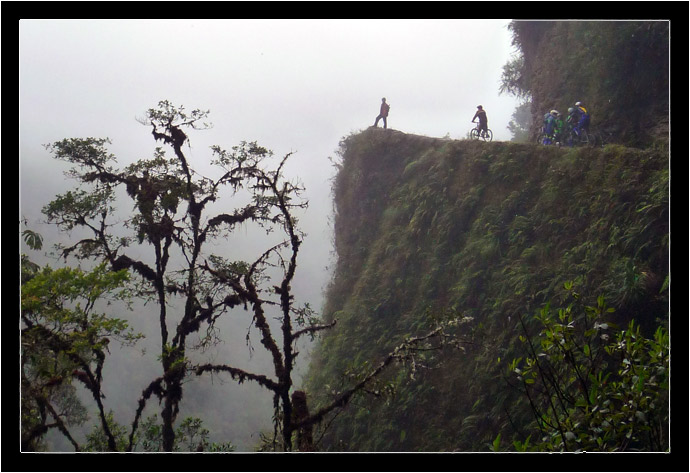
- Mountain Biking tours have only been running down the road for the last 10 years or so. We heard that anywhere from 12 to 30 tourists and guides have died on the road since then (the best estimates put the number at 18.) It is a dangerous road, but approximately 25,000 bikers ride down every year. I firmly believe it’s safer to bike down, than drive.
- A new road, the South Yungas Road, opened in 2007. It’s a two-lane, concrete road throughout, and guardrails protect every dangerous curve. Despite those precautions, there are still deadly accidents – the terrain itself conspires against drivers. Furthermore, many people would still rather drive up and down the original road if only because there’s less traffic to contend with now. (In fact, our bus driver was planning to drive us back to La Paz on the “Death Road” after our tour, but (fortunately!) there was a new landslide he couldn’t get around, so we were forced to take the “safe road” home.)
- I was very impressed with the company we chose, Gravity Assisted Mountain Biking. The mountain bikes they gave us were in perfect condition, literally the best equipment I’ve ever ridden on. Excellent brakes, front and back suspension, and big, knobby tires. Riding someone else’s bike can be iffy, but not in this case. Their bikes are probably better than your bike.
- Gravity Bolivia also handed out gear to mitigate the weather. Windbreakers, helmets, ski goggles, gloves, safety vests, and jump pants, not to mention rain gear if you wanted that, too.

- After the trip, we were loaded down with freebies! Each rider received a high-quality T-shirt, deck of playing cards, pen, buff, and a CD-ROM full of photos and videos taken by one of the guides on the way down the road. In all our travels, we’ve never seen any company so generous with free giveaways! That made the USD$100 price tag much easier to swallow. (My only complaint was that the videos were recorded on an inexcusably low-quality setting.)
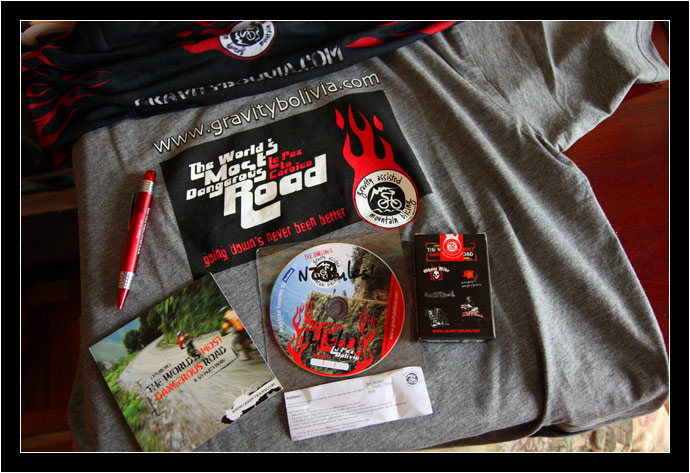
- If a monkey reserve isn’t your type of thing, an optional zip line tour was also offered at the bottom of the World’s Most Dangerous Road. Oksana and I skipped it. You do one zip line, you’ve done them all.
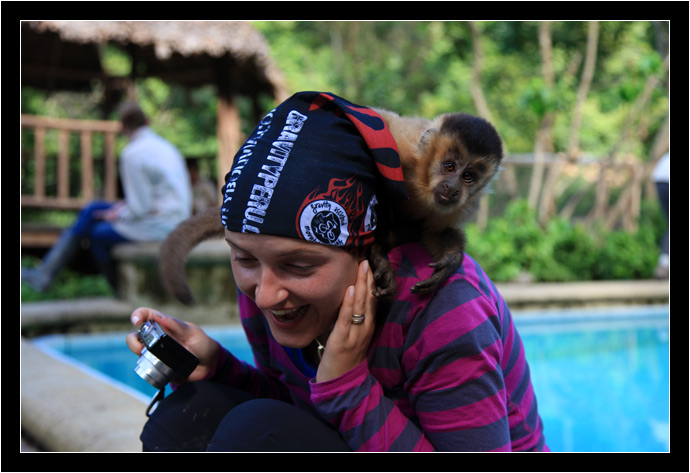
- At La Senda Verde, the monkey reserve, we learned that just two days prior, a new decree had been passed down from the owners: Visiting tourists were no longer allowed to touch the monkeys. (As opposed to the volunteer tourists who were working at the reserve, who were.) The reason was because some of the monkeys had been catching colds from sick humans and the hope was that limiting contact would keep them healthy. We respected the new rules, but no one seemed to have told the monkeys.
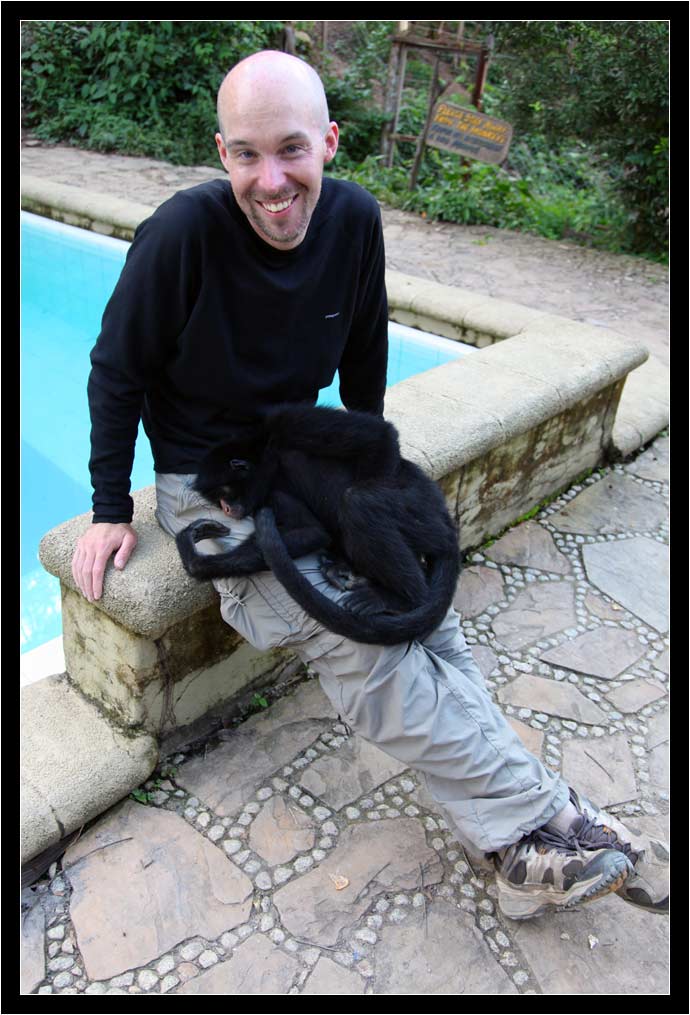
- Just after I finished editing this video, Oksana and I downloaded and watched Top Gear’s Bolivia Special (Season 15, episode 6.) Very entertaining, but we knew enough to know when they were over-dramatizing things and even staging certain scary situations on the Yungas Road. For instance, we knew right away that the Jeremy Clarkson segment – where he’s inching by another car with his tire off the edge of a cliff – was fake because he had inexplicably turned his car around and started heading down the mountain road!
Episode Notes:
Gravity Assisted Mountain Biking
La Senda Verde
The Yungas Road (Wikipedia)
Cycling the world’s most dangerous road (BBC News)
Top Gear Bolivia Special (Youtube)
Our Recommended Tours page for South America
Contour HD helmet-mounted camera

Great video! I am glad you stuck with it Oksana! I was very nervous on that road as well.
The monkeys were fantastic. They seemed so friendly, how fun.